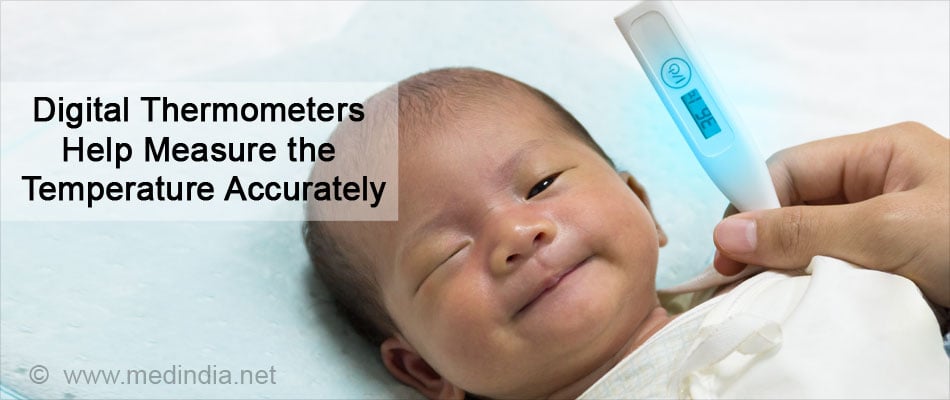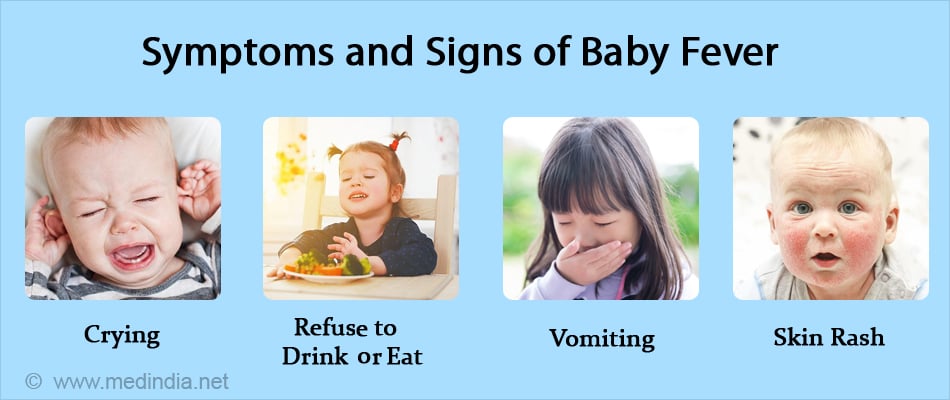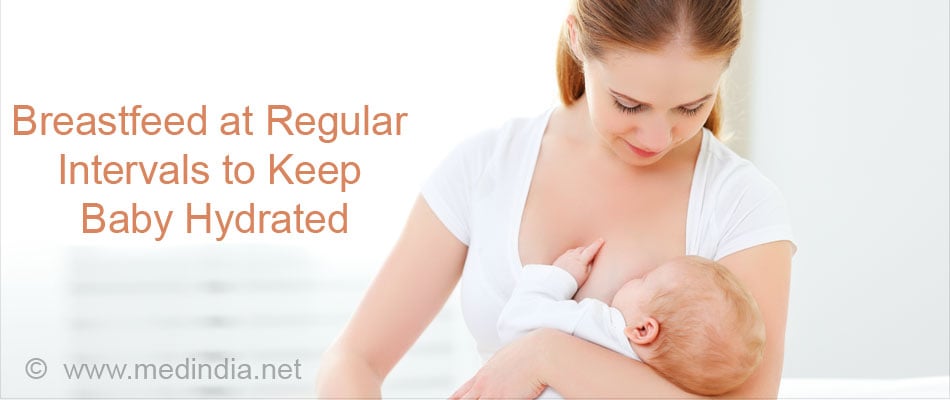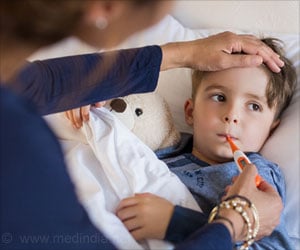- When your baby or infant has a fever - (https://medlineplus.gov/ency/patientinstructions/000319.htm)
- Meningitis - (http://kidshealth.org/en/parents/meningitis.html)
- Fever in Infants and Children - (https://familydoctor.org/condition/fever-in-infants-and-children/#overview)
- Fever and Taking Your Child’s Temperature - (http://kidshealth.org/en/parents/fever.html#)
- Symptoms - (http://www.mayoclinic.org/diseases-conditions/fever/basics/symptoms/con-20019229)
- Infant and toddler health - (http://www.mayoclinic.org/healthy-lifestyle/infant-and-toddler-health/in-depth/thermometer/art-20047410?pg=2)
What is Baby Fever?
Fever in babies or children under 5 years of age is defined as an oral temperature above 99.5°F (37.5°C), a rectal temperature above 100.4°F (38°C) or an axillary temperature (under the arm) of above 99°F (37.2°C).
The average temperature in babies is 98.6°F (37°C) when taken orally (mouth) and 99.6°F (37.5°C) when taken rectally (in the bottom). The hypothalamus maintains the normal body temperature by regulating the body's internal thermostat.
During the day, it is normal for the temperature to fluctuate in children. It is usually lower in the morning and rises as the day progresses. It can also vary according to the child's activity.
More than 60% of parents with children aged between six months and five years, report a case of fever in their children.
Though high temperature can be a cause for concern for most parents, it is usually self-resolving and disappears in a few days.
If the rise in temperature persists for 24 hours, then the child is diagnosed with fever, indicating some underlying illness. The illness may often be harmless and triggered by mild viral infections like cold and cough.
The hypothalamus resets the body to a higher temperature in response to an infection, illness, or some other cause, to fight off the germs that cause infections.
What are the Causes of Baby Fever?
Fever is usually a symptom of an underlying illness and not an illness on its own. Few factors that trigger fever in infants are:
1. Infections: These are the most common cause of fever in children. Fever helps the body to fight infections, by stimulating natural defense mechanisms.
Viral - Most infections are viral, which are responsible for colds and upper respiratory infections. Common infectious diseases of childhood, such as chickenpox and measles can also cause fever. Viral infections do not necessarily need treatment except to alleviate some symptoms and they resolve on their own after proper care in a few days.
Bacterial- Bacterial infections including certain ear and throat infections, urinary tract infections, pneumonia, blood infections and meningitis are not self-resolving and need treatment with antibiotics.
Inflammation of the meninges, the membranes that cover the brain and spinal cord is called meningitis. Most cases are caused by bacteria or viruses, but some can be due to certain medicines or illnesses.
Bacterial meningitis is usually a serious and life-threatening condition if not treated promptly.
Viral meningitis (also called aseptic meningitis) is more common and far less serious and resembles a flu.
Fever accompanied by an extreme sore throat can be caused by Streptococcus. If not treated with antibiotics, this infection can lead to rheumatic fever or heart damage.
2. Overdressing: As temperature regulation is not fully developed in infants, sometimes overdressing them or being in a hot environment can lead to a rise in their temperature.
3. Immunizations: Low-grade fever after vaccinations is common in babies and toddlers.
4. Lesser known causes: Some gastrointestinal conditions like gastroenteritis, some tumors or chronic joint inflammation can cause fever. Testing can also cause a slight rise in temperature but usually does not increase the temperature beyond 100°F (37.8°C).
How Do I Take My Baby's Temperature?
Gently placing the back of the hand on the skin of the forehead or a gentle kiss often gives a hint about raised body temperature. This method of taking a temperature is called tactile temperature. It does not give an accurate measurement.
Also, fevers can rise and fall. The child might experience chills as the body's temperature begins to rise or the child might sweat to release extra heat as the temperature starts to drop.
Therefore, it is always advisable to use a reliable thermometer to confirm a fever.
Most commonly used thermometers:
- Glass Mercury Thermometers- It was commonly used in the past but it carries the risk of possible exposure to mercury, which is an environmental toxin.
- Digital Thermometers- This thermometer should be used to measure temperature in infants and children. It usually gives the quickest and most accurate readings. Digital thermometers can be used to take oral (in the mouth), rectal (in the bottom) and axillary (under the arm) temperatures. An axillary reading is less reliable but can be useful for screening at any age. The thermometer beeps, usually in about 15 seconds and displays the temperature on the digital display.

- Ear (tympanic) Thermometers– These devices can be used to take a quick temperature reading from the ear, but are expensive to buy. They can also give wrong readings especially if not placed properly into the ear canal, which is small in infants or if there is a build up of ear-wax. This thermometer is not suited for infants 6 months or younger.
- Temporal Artery Thermometers- These devices have an in-built infrared scanner that reads the temperature of the temporal artery on the forehead.
Appropriate thermometer for different age groups:
- For babies younger than 3 months- Use a digital thermometer to take a rectal temperature. Temporal artery thermometers may also give accurate readings for kids in this age group.
- For babies between 3 months and 6 months old- The best choice would be to use a digital thermometer to measure rectal temperature.
- For kids between 6 months and 4 years old- Use a digital thermometer to take a rectal temperature or axillary temperature, a temporal artery thermometer, or an electronic ear thermometer.
- For kids 4 years or older- Using a digital thermometer to take the oral temperature is the most reliable means.
Modes of Taking Temperature
To take the rectal temperature:
The end of the thermometer should be washed with soap and water and the tip of the thermometer should be moistened with a lubricant, such as petroleum jelly.
There are two positions in which the baby can be placed:
- belly-down across on a firm, flat surface
- or face-up with legs bent towards the chest
The lubricated end of the thermometer is inserted into the anal opening about ½ inch to 1 inch, or until the tip of the thermometer is fully in the rectum.
Insertion should be stopped if resistance is felt. Wait until the thermometer beeps or sends other signals that the temperature is ready to be read.
To take the oral temperature:
Oral temperatures should not be taken until 20 to 30 minutes after the child finishes eating or drinking.
Place the tip of the thermometer under the tongue and ask your child to gently close his or her lips around it. The child must be reminded not to bite down or talk, and to relax and breathe normally through the nose.
Oral temperatures can be half a degree lower than the body temperature.
Wait until the thermometer beeps or sends other signals that the temperature is ready to be read.
To take an axillary temperature:
This is a convenient way to take a child's temperature. Although not as accurate as a rectal or an oral temperature, some parents prefer to take an axillary temperature, especially for kids who cannot hold a thermometer in their mouths.
Remove the child's shirt and undershirt, and place the thermometer under the armpit. Fold your child's arm across the chest to hold the thermometer in place.
Wait until you hear the appropriate number of beeps or any other signal that indicates that the temperature is ready to be read.
What are the Symptoms and Signs of Baby Fever?
The baby's temperature should be taken if one of the following is apparent:
- If the skin feels warmer than usual
- Increased irritability, fussiness and crying
- Increased sleepiness
- Crying in pain
- Refusing to drink and eat
- Refusing to breastfeed
- Suffering from diarrhea or vomiting
- Having breathing difficulties
- Has a stiff neck
- Swelling of the soft spot on an infant’s head
- Not responding or less active
- Skin rash

A fever caused by any illness may contribute to dehydration.
Temperature does not remain constant throughout the day. Sometimes the child may sweat as the temperature drops. If the child or infant is not kept well-hydrated, they begin to show signs of irritability.
Dehydration can develop more quickly in children suffering from vomiting or diarrhea. Therefore, it is important to encourage the child to drink plenty of water if they have a fever.
Signs of dehydration include a dry mouth, no tears, sunken eyes, drowsiness and generally becoming more unwell. Seek medical help if you suspect that your child is becoming dehydrated.
If temperatures rise too high, febrile convulsions may occur.
These are seizures that happen because of fever. They occur in about 4% of children between the ages of six months and five years.
Children outgrow febrile convulsions by the age of 4-5 years. Though they are a cause for concern, febrile convulsions have no long-term consequences.
How do you Diagnose Baby Fever?
The baby can be suspected of having a fever if:
- The skin on their forehead, back or stomach feels hotter than usual
- The cheeks are flushed
- The skin is excessively sweaty
- Shows signs of irritability or restlessness
- Does not eat / drink / breastfeed
The quickest and most effective way of confirming the diagnosis in babies is by using a digital thermometer. Thermometers give fast and accurate readings.
How do you Treat Baby Fever?
Previously, doctors recommended treating infants or children on the basis of temperature alone. But now, before prescribing medicines, the overall activity and condition of the infant is judged.
If the baby is between 3 months of age and 3 years and has a low-grade fever below 102°F (38.8°C), it is advised to avoid medication. But if the baby is fussy and irritable, and temperature reads above 102°F (38.8°C), antipyretics like paracetamol or acetaminophen can be considered.
For a baby younger than 3 months of age, a rectal temperature of 100.4°F (38°C) or higher, should be treated as a sign of serious infection.
Despite fever, the illness may not be serious if the baby/child:
- is alert and active
- is interested in playing and engaging
- is eating / drinking / breastfeeding
- has a normal skin color
The child’s doctor should be contacted if:
- The child is under 3 months and has a fever of 100.4°F (38°C) or higher
- The child is between 3 to 6 months and has a temperature up to 102 F (38.9 C) and seems unusually irritable, lethargic or uncomfortable, or has a temperature higher than 102 F (38.9 C)
- The child is above 6 months up to 24 months and has a fever of 102 F (38.9 C) or higher
- If the fever lasts for more than 5 days
- If the child has a febrile seizure
How do you Manage Fever in Babies?
Look out for signs of dehydration- Fever can contribute to dehydration. Dehydration can develop quickly if fever is accompanied by diarrhea and vomiting.
Infants should be breastfed at regular intervals and children should be encouraged to drink plenty of fluids if they have a fever.
If fever is accompanied by vomiting and diarrhea, the doctor might prescribe an electrolyte (rehydration) solution made especially for kids.

Do not force feed-Fever in general, reduces appetite. Allow children to eat what they want to eat and do not over-feed.
Adequate rest- Ensure that the child gets adequate rest.
Lukewarm bath- Lukewarm sponge bath helps in bringing down the temperature. Do not run cold baths or ice and alcohol rubs as it can worsen the situation.
No bundling up- Extra layer of clothing prevents the temperature from coming down. One layer of light clothing is advisable.
Comfortable environment- The temperature in the room should neither be too hot or cold. It should be comfortable. Opening the window or a fan may help.
Health Tips
Plenty of fluids to drink: Keeping the body hydrated will help the body cool itself down.
Wet compresses: Using wet compresses on the forehead, calves and wrists may help to bring the temperature down.
Light dressing: Dressing in light cotton clothes will help the body heat to escape.
Rest: Excessive moving around can raise the body temperature. Adequate rest is advocated.









